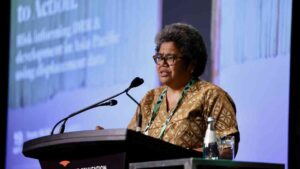One of the most controversial moments in early HIV/AIDS research occurred in March 1991. At a meeting in Washington, D.C., doctors, researchers, and pregnant women of color living with HIV gathered to talk through the pros and cons of a key clinical trial. Suddenly, a group of activists—primarily white, lesbian, and HIV negative—burst in to disrupt the proceedings. Some participants fled the meeting.
The trial was looking into whether giving pregnant women the HIV medication AZT (also known as zidovudine or Retrovir) would prevent transmission of HIV to their babies. At that time, AZT was the only drug approved in the U.S. to treat HIV—but it was already known to have severe side effects and to be only temporarily effective against the virus when used by itself. The women—part of the historic activist group ACT UP—were protesting the trial because they felt it only cared about the welfare of the babies, not the women taking AZT.
In fact, as later became clear, many of the women living with HIV in the meeting were aware of the drug’s risk to their health but were still highly invested in preventing the transmission of HIV to their children.
Despite the interruption, the trial ultimately went forward—and eventually confirmed that when given to pregnant people living with HIV and to their newborns, AZT dramatically reduced the incidence of babies acquiring HIV from their birthing parent. But the incident—in which a group of largely white, middle-class, HIV-negative women forcibly interrupted a meeting involving research focusing on low-income women of color living with HIV—left a bitter taste for many in the room.
One of those people—a Black doctor by the name of Janet Mitchell, M.D., M.P.H.—later described the disruption as led by “a bunch of gay white women deciding what’s right for people of color.” She added: “I felt the activists were paternalistic and didn’t understand the trial was an opportunity for women to have all the options available to them. Poor doesn’t mean dumb.”
Mitchell served Black and Latina women living with HIV and their children at the public Harlem Hospital in the 1980s and 1990s. She was one of very few Black female doctors nationwide serving communities of color at a time when the devastating effects of AIDS in such communities was underreported. Instead, media attention and advocacy efforts tended to focus on populations of white gay men affected by the virus.
Mitchell’s contributions, likewise, have been only sporadically reported despite her pathbreaking career. That career ended in the late 1990s, when she was diagnosed with early Alzheimer disease. She died at age 69 on Sept. 1, 2019. This year marks the 75th anniversary of her birth.
Ambition From an Early Age
Mitchell was born amid segregation in 1950 in Lexington, Kentucky. Her father was a jockey, horse trainer, and janitor who hadn’t gone past fifth grade. But even in the face of these circumstances, he greatly valued educational advancement for his children. Petite and precocious despite having dyslexia, Mitchell “was always very driven and excelled in math and science,” her sister, Blanche Hughes, a college administrator in Colorado, told TheBody. “She participated in science fairs and special programs for high school students at the University of Kentucky. She was very competitive and very smart, and she liked being smart.” She also learned to make her own clothes because she was so small.
Hughes said that amid desegregation and during her senior year of high school, Mitchell’s all-Black school closed. From there, she was sent to a white high school where she lost her position as first in her class. “That was tough for her,” recalled Hughes.
After graduation, Mitchell went to Mount Holyoke College, then to medical school at Howard University, and finally to Harvard for her master’s in public health. She came to Harlem Hospital via her residency and ended up becoming chief of perinatology in the hospital’s Department of Obstetrics and Gynecology from 1988 to 1996.
At Harlem Hospital, Mitchell ran New York City’s largest prenatal program for pregnant women with drug dependencies. A page celebrating Mitchell’s workexists within a special U.S. National Library of Medicine online exhibit entitled “Changing the Face of Medicine.” The page quotes her as saying: “Working at Harlem and doing almost all of my rotations in medical school at D.C. General Hospital, I said, ‘There but by the grace of God go I.’ I have ever since devoted myself to the underserved and the most disenfranchised.” Hughes added, “She cared deeply about her patients and loved working at Harlem Hospital.”
For years at Harlem Hospital, Mitchell worked alongside Pat Loftman, M.S., another Black woman who was part of the hospital’s midwife program that was started in 1968. Loftman told TheBody that when she came to the hospital in 1982, medical professionals were just beginning to talk about the mysterious and deadly new disease that, later that year, would come to be called AIDS. “I remember thinking, ‘Lord, thank you that this only affects men so I’ll never have to deal with it,’” she said.
But, of course, that was not the case at all.
Caring for the Epidemic’s Most Ignored
In the early 1980s, Harlem Hospital served many pregnant low-income women who had become dependent on crack. According to Loftman, patients were “coming into our emergency department in full-blown labor who’d had no prenatal care.
“Dr. Mitchell said, ‘We have to get women like this into prenatal care,’ but, then as now, most providers don’t want to treat women using substances,” Loftman recalled. “Dr. Mitchell went to our chair and said, ‘We have to design a program just for these women.’ So she literally created what was called ‘special prenatal.’ She couldn’t find a physician besides herself who wanted to care for these women, so she turned to us midwives. And she was revolutionary because she believed that all women should be cared for by a midwife, because we take care of the entire woman.”
The program included a drug counselor—a woman who’d once been dependent herself, Loftman said—and who would help the women get into treatment programs if they so desired.
Once AIDS came into the picture, Mitchell was quick to respond, Loftman said. The first step she took has since become so common as a standard of care that it’s hard to believe it had to start somewhere: Once HIV testing became available in 1985, she instituted a policy of universal HIV screening for pregnant women. “We weren’t formal with the women,” said Loftman, “which encouraged them to come, because they felt safe with us. If it wasn’t for Dr. Mitchell, people would’ve ignored Black and Brown women.”
Natalia Kanem, M.D., M.P.H., the executive director of the United Nations Population Fund, studied and worked under Mitchell. Kanem remembers Mitchell as being “under five feet tall but with a generalissimo personality. She was very bossy but also very effective in shepherding the potential she saw in students, and not just Black students, who were serious about what we now call reproductive health.”
Kanem said that Mitchell was “defending pregnant, drug-[dependent] women” at a time when “all the caring went to the baby, and mothers on drugs were told, ‘You’re a bad mother, you’re addicting your fetus to your drugs, and you should go to jail.’ Few people stood up for poor pregnant women the way Janet did.”
An Early End to a Momentous Career
In 1996, Mitchell moved from Harlem Hospital to Lincoln Medical and Mental Health Center in the Bronx, where she served as director of outreach, chief of obstetrics, and residency director in the Department of Obstetrics and Gynecology and Reproductive Medicine. But after entering her 50s, colleagues, friends, and family began to notice that she was becoming forgetful and unable to keep up with workplace demands. She left the position in 2004.
Throughout Mitchell’s career, she lived in a brownstone in Brooklyn, first with a husband in a marriage that ended in divorce, then alone. After retiring, and while struggling with deteriorating mental faculties, she sold her home for a fraction of its worth to a predatory agent. In 2007, she was brought to live with her sister, Blanche Hughes, in Colorado. Shortly afterward, Hughes entrusted Mitchell’s care to a nearby nursing home where she lived until her death in 2019.
Hughes said she wanted her sister to be remembered as a trailblazer. “She was so short that she needed a stool to perform surgery,” she noted. But, though some might have felt oppressed by their small stature, Hughes said that when hospital staff told Mitchell that she should buy her own surgical gloves because her hands were too small for the standard ones, she refused and made them buy her appropriately fitting gloves.
Even in the nursing home, while struggling with Alzheimer disease, Hughes said her sister would go into the rooms of residents close to death—“She always seemed to know when people were dying”—and hold their hands.
Looking back on her career, Hughes remembers Mitchell as “an advocate for low-income women of color when others were ignoring them or making assumptions about them. She used her research and her advocacy for them.”
Mitchell herself clearly saw that as one of her greatest sources of pride. As she put it within her “Changing the Face of Medicine” profile: “I have kept my commitment over time … to providing the best of care to women—especially women of color and those with the diseases of addiction and HIV.”
Source: https://www.thebody.com/hiv/janet-mitchell-hiv-physician-1980s-1990s-black-latina-women




